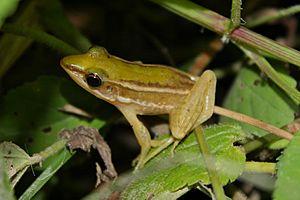Taipei frog facts for kids
Quick facts for kids Taipei frog |
|
|---|---|
 |
|
| Conservation status | |
| Scientific classification | |
| Synonyms | |
|
The Taipei frog (Hylarana taipehensis) is a small, colorful frog found in parts of Asia. It's also known by many other names, like the Taipei grass frog or stripe-backed frog. You can find these frogs in countries such as China, Thailand, Laos, Cambodia, and Vietnam.
These frogs are quite adaptable. They can live in many different places, even near people. You might spot them on farms or in cities, especially where there are lots of trees close together.
Contents
What Does the Taipei Frog Look Like?
The Taipei frog is a small amphibian. Adult frogs usually grow to be about 4.0 centimeters (about 1.6 inches) long. That's roughly the length of your thumb!
Colors and Markings
Taipei frogs come in a variety of colors. They can be bright yellow, green, or brown. Sometimes, they even have a mix of these colors. A cool feature is the dark brown markings on the sides of their heads. These markings help them blend in with their surroundings.
How They Stay Hidden
Their varied colors and patterns are great for camouflage. This means they can hide easily among plants and leaves. This helps them avoid predators, which are animals that might try to eat them.
Where Do Taipei Frogs Live?
Taipei frogs live in warm, wet places in Southeast Asia. They prefer areas with lots of water and plants.
Preferred Habitats
- Forests: They like forests where trees grow close together, providing shade and moisture.
- Wetlands: Ponds, swamps, and rice paddies are perfect homes for them.
- Human-made areas: Surprisingly, they can also live near people. This includes farms and even some city areas, as long as there's enough water and greenery.
Daily Life of a Taipei Frog
During the day, these frogs usually stay hidden. They like to rest in places where trees and plants are dense. This keeps them cool and safe from predators. At night, they become more active, looking for food.
What Do Taipei Frogs Eat?
Like most frogs, Taipei frogs are carnivores. This means they eat other small animals.
Their Diet
- Insects: Their main food source is insects. They use their long, sticky tongues to catch flies, mosquitoes, and other small bugs.
- Other small creatures: Sometimes, they might also eat tiny spiders or other small invertebrates they find.
Life Cycle of the Taipei Frog
The life cycle of the Taipei frog is similar to many other frogs. It involves several stages, starting from an egg.
Reproduction
Taipei frogs usually lay their eggs in water. This often happens in ponds, slow-moving streams, or rice paddies. The female frog lays many small eggs, which are then fertilized by the male.
From Egg to Froglet
- Eggs: The eggs hatch into tiny tadpoles.
- Tadpoles: Tadpoles live in the water. They look like small fish and breathe through gills. They eat algae and other plant matter.
- Metamorphosis: As tadpoles grow, they start to change. This process is called metamorphosis. They develop legs, their tails shrink, and their gills are replaced by lungs.
- Froglets: Once they have fully developed legs and lungs, they become froglets. These young frogs are ready to leave the water and live on land.
Adult Frogs
After growing a bit more, froglets become adult frogs. They will then be ready to reproduce and continue the life cycle.
Conservation Status
The Taipei frog is currently listed as "Least Concern" by the International Union for Conservation of Nature (IUCN). This means that, for now, their population is stable and they are not considered to be in danger of disappearing.
Why They Are Not Endangered
- Wide range: They live in many different countries.
- Adaptability: They can live in various habitats, including those changed by humans.
- Healthy numbers: Their populations are still strong in many areas.
However, it's always important to protect their habitats. Keeping wetlands and forests healthy helps all animals, including the Taipei frog.


